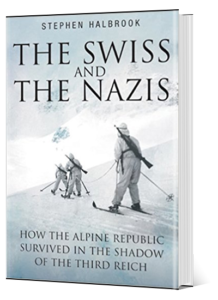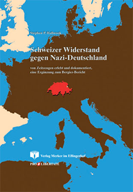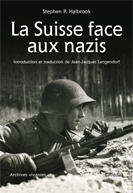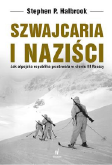
The Swiss & the Nazis (2006): How the Alpine Republic Survived in the Shadow of the Third Reich
by Stephen P. Halbrook
Published by Casemate Publishers (2006)
TRANSLATIONS
SUMMARY
While surrounded by the Axis powers in World War II, Switzerland remained democratic and, unlike most of Europe, never succumbed to the siren songs and threats of the Nazi goliath. This book tells the story with emphasis on two voices rarely heard. One voice is that of scores of Swiss who lived in those dark years, told through oral history. They mobilized to defend the country, labored on the farms, and helped refugees. The other voice is that of Nazi Intelligence, those who spied on the Swiss and planned subversion and invasion. Exhaustive documents from the German military archives reveals a chilling rendition of attack plans which would be dissuaded in part by Switzerland’s armed populace and Alpine defenses.
Laced with unique maps and photos, the book is organized into four units. The first, “A War of Words and Nerves,” reveals German prewar subversion plans. Chapters also depict how the Swiss mobilized an active “spiritual defense” of their country, including the use of the press and cabaret as weapons against totalitarianism, and the role of Swiss newsreels in building the spirit of resistance.
The second unit, “Preparing for Invasion,” concerns military preparations. Swiss soldiers recall an epoch when every day could have been “the day” when all hell would break lose and they would meet the enemy. Blitzkrieg plans against Switzerland devised by the German Wehrmacht in 1940 are described in detail. Switzerland was an armed camp with countless fortifications, against which the Axis could have attempted access with extreme costs in blood. In Switzerland, Jews—like all other citizens—were in arms, and Jewish officers served in the highest levels of the Swiss army.
“Struggle for Survival: Food, Fuel and Fear,” the third unit, presents oral histories of daily life during the war with its shortages, alarms, and rumors. Jokes and slurs the Swiss devised to characterize the “Nazi pigs” are told. Daily life is probed, including the role of women in the military and the economy. A chapter on the refugee crisis investigates whether Swiss officials played a role in Germany’s adoption of the “J” stamp on Jewish passports, how Switzerland became a lifeboat for refugees, and how asylum policies were liberalized as the persecution of Jews escalated.
“Espionage and Subversion,” the fourth and final unit, covers strategic issues and intelligence activities. German attack plans and bickering in the Gestapo about who would rule a conquered Switzerland persisted. One chapter focuses on Davos, where the Swiss struggled against a Fifth Column and which became a safe haven for American airmen whose crippled bombers made it to Swiss territory. The last chapter profiles Switzerland as America’s window on the Reich—how Allen Dulles and his OSS spied on the Nazis, at times with help from Swiss Intelligence.
Halbrook’s other books include the award-winning Target Switzerland: Swiss Armed Neutrality in World War II, which was published in five languages.
CONTENTS
Introduction
Part I: A WAR OF WORDS AND NERVES
1. The Spirit of Resistance
2. The Eyes of German Intelligence
3. Hanging Hitler in Satire
4. Counterattack of the Newsreels
Part II: PREPARING FOR INVASION
5. I Was a Militia Soldier Then
6. Blitzkrieg 1940
7. Switzerland Is a Porcupine
Part III: STRUGGLE FOR SURVIVAL: FOOD, FUEL, AND FEAR
8. Gas Masks and Potato Bread: An Oral History
9. The “J” Stamp, the Lifeboat, and Refugees
Part IV: ESPIONAGE AND SUBVERSION
10. The Consequences of Encirclement
11. Intruders in Our Midst
12. America’s Window on the Reich: Allen Dulles in Bern
Conclusion
NOTEWORTHY REVIEWS
“Halbrook succeeds not only in achieving a thorough analysis of Switzerland’s armed neutrality, but also in revealing through their own voices the willingness of ordinary citizens to accept total war in order to preserve their freedom.”
― SWISS AMERICAN HISTORICAL SOCIETY REVIEW



